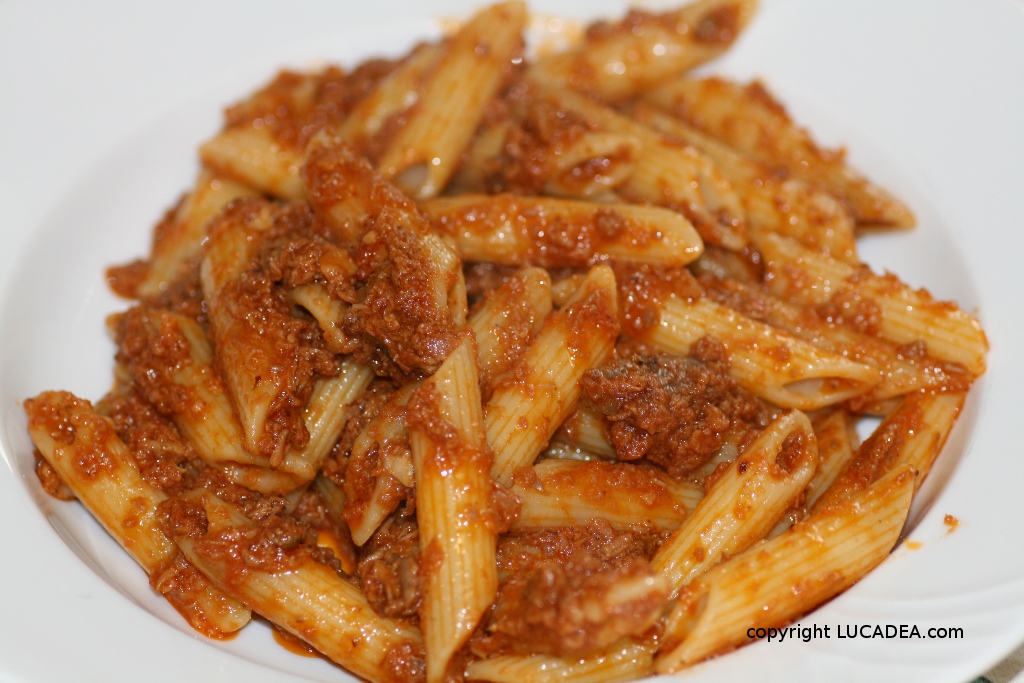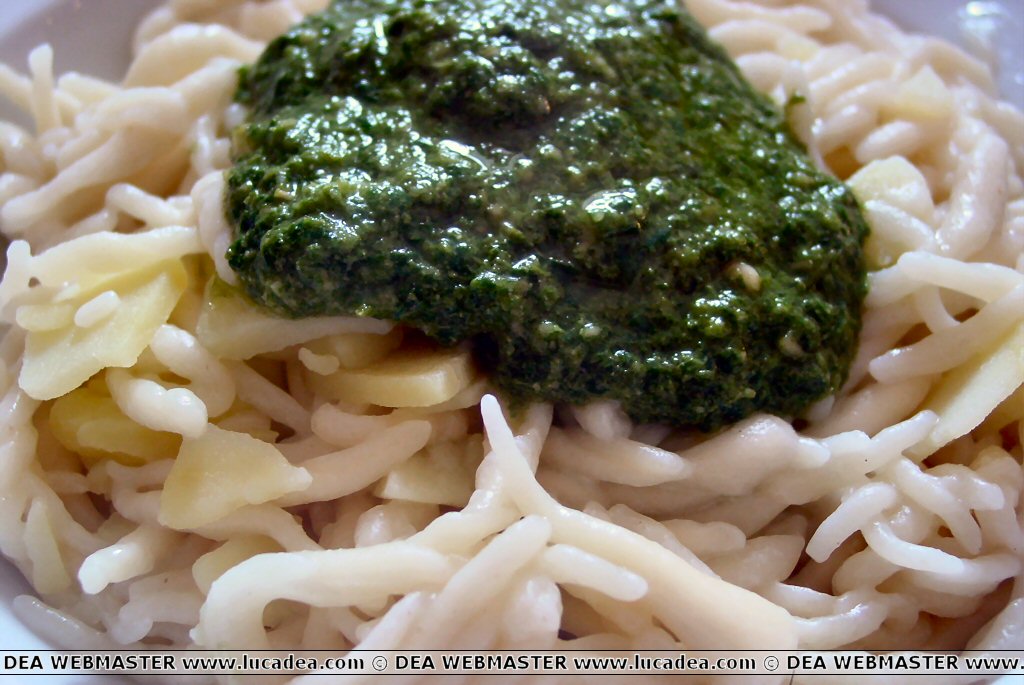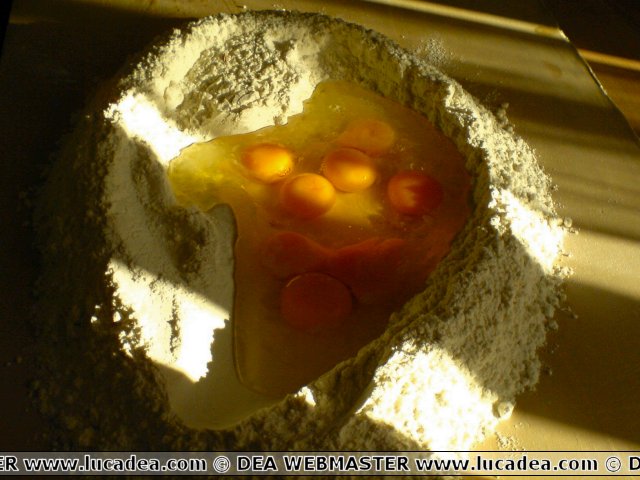Penne al ragù di carne.
Mi viene l’acquolina solo a vederle queste foto (eppure le ho preparate e mangiate oggi a pranzo!).
Un bel piatto di penne al ragù di carne, potrei quasi dire il mio sugo preferito.
Ravioli al ragù di carne
Trofie with Genoese Pesto: the typical Ligurian dish
Trofie with pesto, Genoese style: the typical Ligurian dish.
Trofie with pesto (with some potatoes) is one of the typical dishes (or at least one of the typical pastas) of Genoa.
Do you like them? Add a comment or go to the bottom of the site to read what other visitors have written.
Here are two beautiful photos:
Photo taken with Canon 600D and lens Canon 18-55 EFS.
I refer you back, here, to the short but clear recipe written for me by the Chef Loris.
Trofie are a type of pasta typical of Ligurian cuisine, elongated and thin, trofiette, believed to originate from Sori, in the province of Genoa. It should be noted that in the Ligurian language the term trofie indicates "gnocchi" and trofietta indicates a "gnocchetto", a pasta made of flour and potatoes, with a substantially different shape and consistency on the palate.
Continue on Wikipedia
Trofie with Genoese pesto: the typical Ligurian dish – Trofie au pesto génois : le plat typique de la Ligurie – Trofie con pesto genovés: el plato típico de Liguria – Trofie com pesto genovês: o prato típico da Ligúria – Trofie mit genuesischem Pesto: das typisch ligurische Gericht – Trofie với pesto Genova: món ăn Ligurian điển hình
Risotto al ragù
I ravioli fatti in casa da mia mamma
I ravioli fatti in casa da mia mamma.
Ravioli fatti in casa sono un must in Liguria.
Un lavoro stancante e lungo quello di preparare in casa i ravioli.
I risultati però sono impagabili.
L’impasto (farina e uova):
Il ripieno (erbe selvatiche e ricotta):
Poi si stende il ripieno tra le sfoglie tirate con la classica macchinetta a manovella oppure, se vi piace di più, a mano:
Ed infine, con una rotella dentata, si da la forma a questa delizia:
Il raviolo è un prodotto tipico della cucina italiana. Si può descrivere come un quadrato o tondo di pasta all’uovo ripiegato a contenere un ripieno a base di carne, di pesce, di verdure o formaggio, a seconda delle varie ricette locali. Il raviolo può essere servito in brodo o asciutto accompagnato da sughi o salse. La scelta dipende anche dal tipo di ripieno.
Continue on Wikipedia
My Mom’s Homemade Ravioli – Les raviolis maison de ma mère – Raviolis caseros de mi mamá – Ravioli caseiro da minha mãe – Die hausgemachten Ravioli meiner Mutter – Bánh ravioli mẹ tôi tự làm
Un piatto di pansoti alla salsa di noci
Un piatto di pansoti alla salsa di noce.
Pansoti di magro (ripieno di verdure e ricotta) e salsa ottenuta da un pesto di noci (questo fatto in casa!)
Una delizia!
A te piacciono? Lascia un commento cliccandohere.
A dire la verità questi non sono proprio pansoti (che in linea di massima dovrebbero essere triangolari) ma tortiglioni.
I pansoti, pansòti in ligure, o anche pansòtti (dal ligure pansa, in italiano “pancia”), sono una pasta ripiena tipica della cucina ligure, simile ai ravioli.
Continue and learn more on Wikipedia
Pansoti, the typical Ligurian stuffed pasta, seasoned with walnut sauce – Pansoti, les pâtes farcies typiques de la Ligurie, assaisonnées de sauce aux noix – Pansoti, la típica pasta rellena de Liguria, sazonada con salsa de nueces – Pansoti, a massa recheada típica da Ligúria, temperada com molho de nozes – Pansoti, die typisch ligurische gefüllte Pasta, gewürzt mit Walnusssauce – Pansoti, món mì nhồi đặc trưng của vùng Liguria, được tẩm sốt óc chó – Pansoti,典型的利古里亚酿意面,用核桃酱调味 – クルミソースで味付けした、典型的なリグリアンのぬいぐるみパスタ、パンソティ
Pasta alla carbonara
Pasta alla carbonara. Che bel piattino eh?
Magari i puristi potrebbero storcere l’occhio perchè questa è quasi una frittata a cui manca la panna però il risultato è molto gustoso.
Pancetta, uova, olio e pasta (spaghetti nell’occasione).
Facile e veloce!
Come di consueto vi propongo un link alla lettura di qualcosa di più sulla Carbonara. Non amo fare copia ed incolla per cui vi mando alla pagina di Wikipedia per cominciare una lettura.
E il mangiare?
A nice plate of pasta, fusilli, with meat sauce
A nice plate of pasta, fusilli, with meat sauce.
Another specialty of my house: my mother's meat sauce.
This time it's the sauce for the fusilli... fantastic.
I know that some of my visitors don't appreciate these images that much but I like them a lot and then, if I know I can make some passerby's mouth water, I'm fine with that!!!
Do you know the recipe for this sauce or do you want to explain to me how you prepare it? Add a comment or go to the bottom of the site to read what other visitors have written.
Ragù is a condiment made from chopped or minced meat, cooked for many hours over low heat, with varying aromas depending on the local variant, and usually with the addition of tomato. The most popular ragùs in Italy are Bolognese and Neapolitan ragù.
Continua ed approfondisci su Wikipedia
The pasta called “fusilli” with meat sauce – Les pâtes dites “fusilli” à la sauce à la viande – La pasta llamada “fusilli” con salsa de carne – A massa chamada “fusilli” com molho de carne – Die Pasta namens “Fusilli” mit Fleischsauce – Mì ống gọi là “fusilli” với nước sốt thịt – 名为“fusilli”的意大利面配肉酱 – ミートソースのパスタ「フジッリ」
Spaghetti with Genoese pesto, the recipe
Spaghetti with pesto, the recipe.
Maybe it's not the official type of pasta to accompany Genoese pesto (trenette or trofie) but making a plate of spaghetti seasoned with that wonder that nature offers us in these parts is spectacular all the same!
And then it's so simple: basil, oil, salt, garlic, pine nuts and cheese.
And tell me I'm not right...
And here is Loris' recipe for spaghetti with pesto:
The basic ingredients of this typical Ligurian sauce are basil, garlic, olive oil, grated cheese and pine nuts.
Now I want to describe some details about some of these ingredients, details that are accompanied by memories of my childhood and of my maternal grandparents, true Ligurians of the eastern Riviera.
– Basil. Nowadays we rightly talk about the basil of Prà which has the perfect characteristics for pesto but once they didn’t even know what it was: my grandfather used to say that the perfect basil without the bad smell of mint had to grow in the shade and that its flowers had to be removed as soon as they sprouted. How could they make pesto on the western and eastern coasts?
– Pine nuts. My grandfather would collect pine nuts under an old pine tree near the house, break their shells and store them in a jar. However, the quantity of them in the pesto was always very limited… When they were finished, my grandmother would buy them an ounce at a time, that is, 25 grams!
– grated cheese: for my grandfather, born in 1886, “cheese” was only Sardinian. He bought one form at a time of the half-aged one, which was consumed sparingly at the table. At the end of the form, the little piece that remained and which in the meantime had become nice and hard was used for cooking, to put on pasta and to make pesto.
– The olive oil must necessarily be Ligurian, due to its characteristics of lightness and fragrance.
Enjoy your meal!
Here I leave you a nice video recipe of GialloZafferano.





















